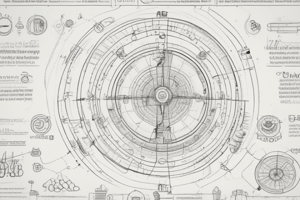Podcast
Questions and Answers
What term is used to describe questions like 'What is your occupation?' and 'Who is your favorite political figure?'
What term is used to describe questions like 'What is your occupation?' and 'Who is your favorite political figure?'
- Structured questions
- Free-response questions (correct)
- Closed-ended questions
- Quantitative questions
Which type of analysis involves summarizing data such as averages and percentages?
Which type of analysis involves summarizing data such as averages and percentages?
- Factorial Analysis
- Correlational Analysis
- Descriptive Analysis (correct)
- Inferential Analysis
What is a key feature of structured questions?
What is a key feature of structured questions?
- They allow for subjective responses.
- They specify response alternatives. (correct)
- They include open-ended format.
- They require detailed analysis.
What does inferential analysis help researchers to do?
What does inferential analysis help researchers to do?
Which example illustrates the use of inferential analysis?
Which example illustrates the use of inferential analysis?
What is the primary purpose of a questionnaire?
What is the primary purpose of a questionnaire?
What is a self-completed questionnaire commonly referred to as?
What is a self-completed questionnaire commonly referred to as?
Which type of questionnaire allows respondents to give answers in their own way?
Which type of questionnaire allows respondents to give answers in their own way?
Which method involves an interviewer physically meeting respondents?
Which method involves an interviewer physically meeting respondents?
What is the main difference between structured interviews and semi-structured interviews?
What is the main difference between structured interviews and semi-structured interviews?
Which of the following is a characteristic of closed questions?
Which of the following is a characteristic of closed questions?
What is a QR code commonly associated with in the context of questionnaires?
What is a QR code commonly associated with in the context of questionnaires?
What type of questionnaire is distributed through the Internet?
What type of questionnaire is distributed through the Internet?
What is the main purpose of listing questions in a questionnaire?
What is the main purpose of listing questions in a questionnaire?
What types of categories can be used in category questions?
What types of categories can be used in category questions?
Which of the following is an example of a ranking question?
Which of the following is an example of a ranking question?
What is the characteristic feature of rating questions?
What is the characteristic feature of rating questions?
What type of question collects a factual amount of a characteristic?
What type of question collects a factual amount of a characteristic?
Which of the following best describes unstructured questions?
Which of the following best describes unstructured questions?
What is an example of a response category that can be used in closed questions?
What is an example of a response category that can be used in closed questions?
In what situation are category questions particularly useful?
In what situation are category questions particularly useful?
Flashcards
Questionnaire
Questionnaire
A list of written questions that respondents answer themselves, often used for surveys.
Open Question
Open Question
A questionnaire that allows respondents to answer in their own words, providing more detailed insights.
Closed Question
Closed Question
A questionnaire that offers respondents a limited set of pre-determined choices.
Web Questionnaire
Web Questionnaire
A questionnaire distributed online, allowing respondents to access it through their web browser.
Signup and view all the flashcards
Mobile Questionnaire
Mobile Questionnaire
A questionnaire accessed through a QR code, usually on a mobile device.
Signup and view all the flashcards
Mail Questionnaire
Mail Questionnaire
A questionnaire sent by post for respondents to complete and return.
Signup and view all the flashcards
Delivery and Collection Questionnaire
Delivery and Collection Questionnaire
A questionnaire delivered in person and collected after respondents complete it.
Signup and view all the flashcards
Telephone Questionnaire
Telephone Questionnaire
A questionnaire where an interviewer asks respondents questions directly over the phone.
Signup and view all the flashcards
List Questions
List Questions
A question that allows respondents to choose one or more answers from a predetermined list.
Signup and view all the flashcards
Category Questions
Category Questions
Questions designed to categorize responses into distinct groups, ensuring only one category fits each answer.
Signup and view all the flashcards
Ranking Questions
Ranking Questions
Questions that require respondents to rank options in order of importance or preference.
Signup and view all the flashcards
Rating Questions
Rating Questions
Questions used to gather opinions or attitudes using a Likert scale - a series of statements with options to agree or disagree.
Signup and view all the flashcards
Quantity Questions
Quantity Questions
Questions where respondents provide numerical answers, typically used to gather data about behavior or attributes.
Signup and view all the flashcards
Unstructured Questions
Unstructured Questions
Open-ended questions allowing respondents to express their answers in their own words.
Signup and view all the flashcards
Structured Questions
Structured Questions
Questions that offer respondents a limited set of pre-defined choices to select from.
Signup and view all the flashcards
Likert Scale Question
Likert Scale Question
A type of structured question that presents a statement and asks respondents how strongly they agree or disagree with it.
Signup and view all the flashcards
Open-Ended Questions
Open-Ended Questions
Questions that allow respondents to give free-form answers, providing detailed insights.
Signup and view all the flashcards
Descriptive Data Analysis
Descriptive Data Analysis
Describing and summarizing data by calculating things like averages, percentages, or creating graphs.
Signup and view all the flashcards
Inferential Data Analysis
Inferential Data Analysis
Using statistical tests to make predictions or confirm ideas based on collected data.
Signup and view all the flashcards
Quantitative Data Analysis
Quantitative Data Analysis
Using collected numeric data to explore and understand patterns or trends.
Signup and view all the flashcardsStudy Notes
Questionnaire Design and Presentation
- A questionnaire is a list of questions whose answers are recorded by respondents.
- Respondents read the questions, understand what is needed, and write down their answers.
- Questionnaires can be self-completed or interviewer-completed.
- Self-completed questionnaires allow respondents to complete the questionnaire on their own, often delivered through the internet.
- Interviewer-completed questionnaires are completed by an interviewer. This includes telephone and face-to-face questionnaires.
- The design of a questionnaire changes based on how it is delivered, returned, and the level of contact with respondents.
Types of Questions
- Questionnaires often use both open and closed questions.
- Open questions allow free-form answers, often used in in-depth or semi-structured interviews.
- Closed questions offer a limited set of choices (e.g., multiple choice, rating scales), categorized as close-ended or forced-choice questions.
- List questions offer predefined responses chosen by the respondent.
- Rating questions assess opinions with scales like Likert.
Category Questions
- Category questions ensure answers fit only into one category.
- Useful for collecting data about specific behaviors or attributes.
- Number of categories shouldn't impact the accuracy of the questionnaire answers.
Ranking Questions
- Ranking questions assess relative importance by ordering items.
- Respondents arrange items from most to least important in the context of specific criteria.
Rating Questions
- Rating questions gather opinion data using Likert-style scales.
- Responses are based on agreement or disagreement with statements.
- Rating scales frequently use 4, 5, 6, or 7 points.
Quantity Questions
- Quantity questions collect numerical data on characteristics.
- Used for situations where factual information is sought e.g., year of birth.
Question Structure
- Unstructured questions allow free-form (open-ended) answers.
- Structured questions provide specific response options (predefined).
Quantitative Data Analysis
- Descriptive analysis summarizes and presents the data; examples include calculating averages and percentages or creating graphs/charts.
- Inferential analysis goes further, making predictions and testing assumptions with statistical methods, e.g., if more studying correlates to better test scores.
Studying That Suits You
Use AI to generate personalized quizzes and flashcards to suit your learning preferences.




